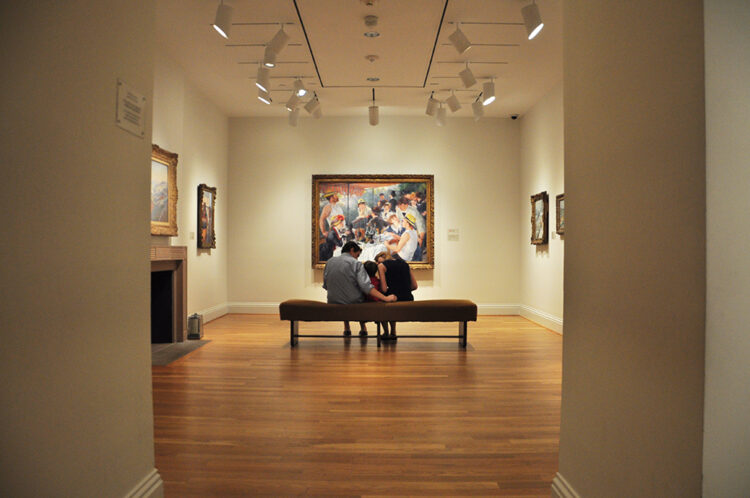DEAI Intern Anissa Santos on the need for resources for museum guests on the autism spectrum or guests that have sensory sensitivities.

Family visiting The Phillips Collection
As the principles of Diversity, Equity, Accessibility, and Inclusion are becoming more commonplace and promoted within museum spaces and other institutions, The Phillips Collection has been committed to actively pursuing and implementing these principles into its institution and galleries. As the Spring 2024 DEAI intern, I have gravitated toward projects that are focused on the accessibility aspect of DEAI.
When most institutions think of accessibility, they usually accommodate for physical disabilities, particularly visible disabilities. While ADA compliance is often associated with accessible buildings, screen captioning, and general accommodations, what about comfortability? For many visitors on the autism spectrum and have sensory sensitivities, their needs tend to be overlooked because there is nothing inherently prohibiting them from entering museums and adjusting their experience for themselves.
In actuality, there are many reasons why those with Autism Spectrum Disorder (ASD) and sensory sensitivities, along with their families, choose not to visit museums. Crowds, lighting, sound, overstimulation, lack of tactile experiences, and lack of awareness among staff are all potential barriers to this demographic of visitors. In fact, a 2016 study showcased that “parents of children on the autism spectrum reported experiencing three times the amount of negative emotions associated with museums compared to parents with non‐autistic children.”[1]
Families with autistic members in both the US and UK have been vocal about their needs, and as a result, we are seeing an increase in resources in Western museums. Some of these resources and changes include the creation of social stories, sensory maps, tactile backpacks, private early morning hours, staff training, and tailored programming. While not all museums may have the capacity to provide all these resources, the Phillips’s DEAI team and I are hoping to pilot a few resources this spring.
Some of the projects I have been working on with the amazing help and assistance of the DEAI, Education, and Security departments include the development of sensory maps, tactile experiences, and a sensory bag resource. It has been amazing to hear a plethora of ideas from all departments and their personal experiences and connections to these communities.
Some may ask why pilot these new initiatives if no one has “complained” about their absence. Others may argue that these resources are not a necessity for this community. Research proves otherwise. In 2020, among 8-year-olds in the United States, 1 in 36 have autism and there has also reportedly been a rise in the rate of autism cases within Black and Hispanic communities.[2] In DC, 16% of kids ages 3-21 were served under the Individuals with Disabilities Education Act during the 2021-22 school year.[3]
Individuals with autism and other disabilities deserve to have museum experiences. If the Phillips makes an active and genuine effort to provide this community with the necessary support to thrive in our galleries, who knows how many more people and families will feel welcome enough to decide to visit? It truly takes a village to make positive change happen, and I am optimistic about the future of these projects. DEAI is not about waiting for someone to request a change but rather constantly advocating for change on behalf of these communities.
Notes
[1] https://www.ncbi.nlm.nih.gov/pmc/articles/PMC9540669/
[2] https://www.dcnewsnow.com/news/health/ap-health/autism-now-more-common-among-black-hispanic-kids-in- us/
[3] https://nces.ed.gov/programs/coe/indicator/cgg/students-with-disabilities
